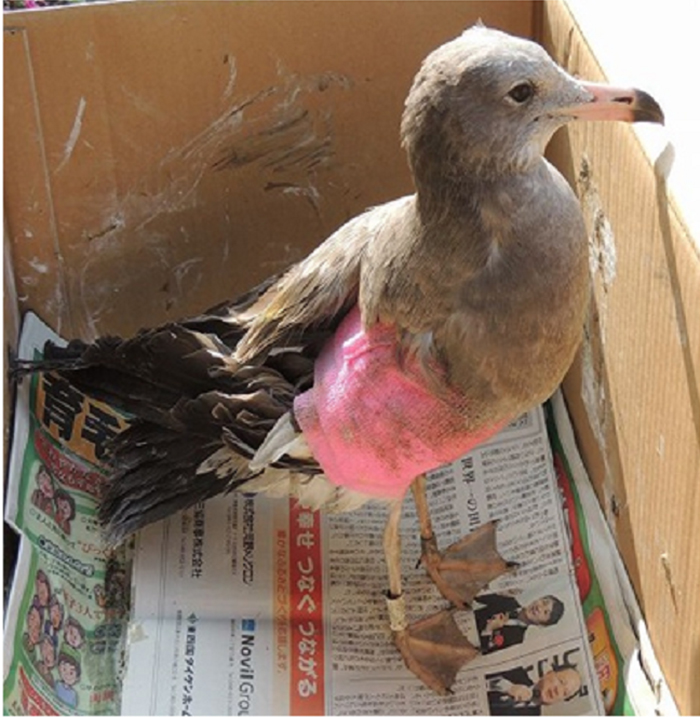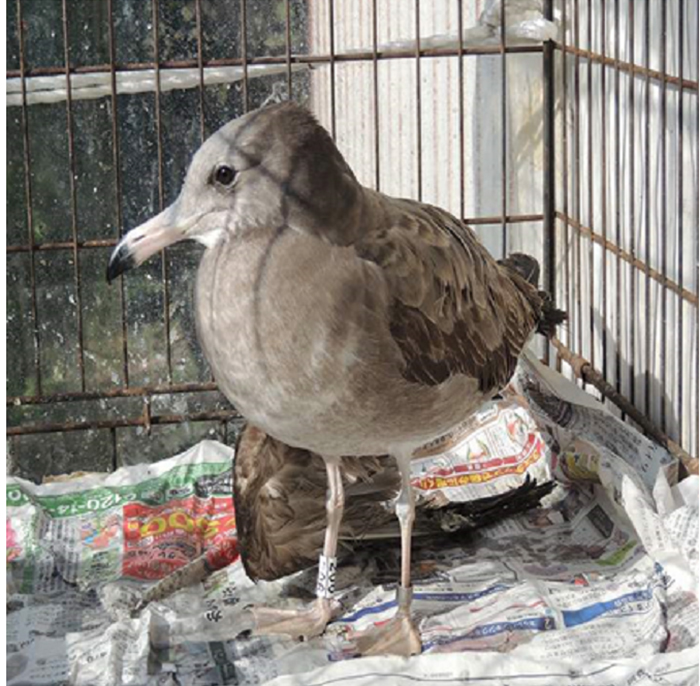
A black-tailed gull with a broken right wing is found and helped in Japan in October 2015. The gull is wearing an ankle bracelet from the Korea National Park Service from last June. Photo: Kazuto Yoshida
A black-tailed gull that was born and tagged in Korea has been found in Tokushima Prefecture, Japan, in eastern Shikoku, some 550 kilometers from its home. This is the first time that scientists have been able to verify just how far a black-tailed gull born on Korean soil can travel.
One of the black-tailed gull chicks tagged in Korea last June was found four months later in October 2015 in Tokushima Prefecture, announced the Korea National Park Service (KNPS). The organization collected the chick near Hongdo Island in Gyeongsangnam-do Province last June and put a research bracelet around its leg. Black-tailed gulls (Larus crassirostris) are seabirds that reside across East Asia, including in Korea, China and Japan, and which reproduce in groups usually on uninhabited islands far from land. The bird leaves its birthplace after only two or three months and then resides there for about three years until it begins mating.
This particular chick had its right wing broken, entwined by fishing line when it was found by a Tokushima fisherman. The bird was sent to the Yamashina Institute for Ornithology where scientists noticed that the bird was wearing a tagged bracelet from the KNPS' Migratory Birds Center.

A gull born in Gyeongsangnam-do Province receives treatment in December last year after being found injured on Shikoku Island. Photo: Kazuto Yoshida
The KNPS also recently announced that a migratory great reed warbler (Acrocephalus arundinaceus) has flown to Korea from Japan and has been found on Heuksando Island. Last August, the organization found the great reed warbler with a tagged tracking bracelet from the Yamashina Institute for Ornithology's branch in Niigata and it informed the institute of the fact in September. This was the second time for a great reed warbler originally tagged in Japan to be found in Korea, as another was first found in April 2012. This bird species migrates to Southeast Asia from Japan to breed in the summer, passing by the southwest coast of Korea.
The KNPS attaches metal or plastic tags to select samples from the bird population. The tags contain information such as identity numbers and tracking devices. Scientists place these on migratory birds every year in order to conduct research into birds' migration routes and into climate change. Over the past decade, the organization has attached tracking tags to a total of 60,954 birds of 244 species, mostly across areas of southern Korea such as Heuksando Island in Jeollanam-do Province and Hongdo Island in Gyeongsangnam-do Province.
By Chang Iou-chung
Korea.net Staff Writer
Photos: Kazuto Yoshida
icchang@korea.kr
